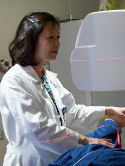Young men have equivalent biochemical outcomes compared with older men after treatment with brachytherapy for prostate cancer Journal Article
| Authors: | Burri, R. J.; Ho, A. Y.; Forsythe, K.; Cesaretti, J. A.; Stone, N. N.; Stock, R. G. |
| Article Title: | Young men have equivalent biochemical outcomes compared with older men after treatment with brachytherapy for prostate cancer |
| Abstract: | Purpose: To evaluate retrospectively the biochemical outcomes of young men treated with low-dose-rate brachytherapy for prostate cancer. Methods and Materials: From 1990 to 2005, 1,665 men with clinically localized prostate cancer were treated with low-dose-rate brachytherapy ± hormone therapy (HT) ± external beam radiotherapy and underwent ≥2 years of follow-up. Patients were stratified on the basis of age: ≤60 (n = 378) and >60 years (n = 1,287). Biochemical failure was defined as a prostate-specific antigen (PSA) nadir plus 2 ng/mL. Univariate and multivariate analyses were used to determine the association of variables with freedom from biochemical failure (FFbF). Results: Median follow-up was 68 months (range, 24-180) for men ≤60 years and 66 months (range, 24-200) for men >60. For the entire group, the actuarial 5- and 8-year FFbF rates were 94% and 88%, respectively. Men ≤60 demonstrated similar 5- and 8-year FFbF (95% and 92%) compared with men >60 (93% and 87%; p = 0.071). A larger percent of young patients presented with low-risk disease; lower clinical stage, Gleason score (GS), and pretreatment PSA values; were treated after 1997; did not receive any HT; and had a high biologic effective dose (BED) of radiation (all ps <0.001). On multivariate analysis, PSA (p = 0.001), GS (p = 0.005), and BED (p < 0.001) were significantly associated with FFbF, but age was not (p = 0.665). Conclusion: Young men achieve excellent 5- and 8-year biochemical control rates that are comparable to those of older men after prostate brachytherapy. Young age should not be a deterrent when considering brachytherapy as a primary treatment option for clinically localized prostate cancer. Copyright © 2010 Elsevier Inc. |
| Keywords: | adult; controlled study; treatment outcome; aged; middle aged; treatment failure; retrospective studies; major clinical study; cancer localization; cancer radiotherapy; comparative study; radiation dose; cancer staging; follow up; methodology; follow-up studies; prostate specific antigen; radiotherapy dosage; radiotherapy; age factors; pathology; oncology; retrospective study; age; risk assessment; cancer hormone therapy; prostate cancer; gleason score; prostate-specific antigen; prostatic neoplasms; goserelin; leuprorelin; blood; iodine 125; radioactive iodine; iodine radioisotopes; dosimetry; prostate tumor; biochemical failure; brachytherapy; gleason scores; radiation therapy; multivariate analysis; age distribution; relative biological effectiveness; external beam radiotherapy; radioisotope; bicalutamide; flutamide; cancer control; regression analysis; relative biologic effectiveness; multi variate analysis; univariate analysis; multivariant analysis; analysis of variance; radioisotopes; erectile dysfunction; urine retention; phosphodiesterase v inhibitor; biochemical control; freedom from biochemical failures; hormone therapy; low dose rate brachytherapy; prostate cancers; diseases; palladium 103; palladium; rectum hemorrhage; prostate brachytherapy; after-treatment; localized prostate cancer; effective dose; biochemical outcome; association of variables; pre-treatment; primary treatment; univariate; fault tolerant computer systems; natural language processing systems |
| Journal Title: | International Journal of Radiation Oncology, Biology, Physics |
| Volume: | 77 |
| Issue: | 5 |
| ISSN: | 0360-3016 |
| Publisher: | Elsevier Inc. |
| Date Published: | 2010-08-01 |
| Start Page: | 1315 |
| End Page: | 1321 |
| Language: | English |
| DOI: | 10.1016/j.ijrobp.2009.06.052 |
| PUBMED: | 20044216 |
| PROVIDER: | scopus |
| DOI/URL: | |
| Notes: | --- - "Cited By (since 1996): 1" - "Export Date: 20 April 2011" - "CODEN: IOBPD" - "Source: Scopus" |



